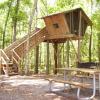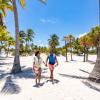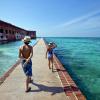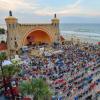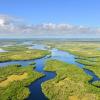How to Explore the Florida Everglades
The legendary River of Grass is one of the wonders of the world, a vast subtropical wilderness that has been declared a World Heritage Site, International Biosphere Reserve and Wetland of International Importance. There are many ways to experience the Florida Everglades National Park – here are nine entry points.
Corkscrew Swamp: Land of Giants
Deep in the heart of Corkscrew Swamp Sanctuary, in the largest stand of old-growth cypress trees on the planet, living giants tower over the primeval landscape. Some of the trees measure more than 135 in height and nearly 40 feet in circumference. A 2.1-mile-long boardwalk leads into the Corkscrew wilderness.
Big Cypress: Brake for Alligators
Along the Tamiami Trail in the 720,000-acre wilderness of Big Cypress National Preserve, alligators line the canal banks like scaly, cold-blooded Lincoln logs. The reptiles reign in the swamp, particularly along the 25-mile Loop Road that leads off the main highway into the deep Everglades.
Step Into the Mystery of Fakahatchee Strand
Venture into Fakahatchee Strand Preserve State Park and you could see an elusive Florida panther, or a black bear, or the famous ghost orchid, which was featured in Susan Orlean’s best-selling book “The Orchid Thief” (which was made into a movie starring Meryl Streep and Nicholas Cage).
Go Rolling Down the Gator Trail
Shark Valley Visitor Center is located 25 miles west of Miami and 70 miles east of Naples. The 15-mile Tram Loop is closed to motorized traffic except for the regular tram tours; many visitors choose to bike the trail, stopping halfway to take in the view from the observation tower.
Store Stocked with Tales of Florida Frontier
Stepping through the doorway of the Smallwood Store on the island of Chokoloskee is like stepping back in time. Opened in 1906 by Florida pioneer Ted Smallwood, the wooden building on pilings is more museum than retail establishment now, with a trove of stories and artifacts from bygone days.
Eat Your Fill, Sit a Spell at Joanie’s
Joanie’s Blue Crab Cafe isn’t fancy, but it serves up heaping helpings of old-fashioned Old Florida character with every plate of fresh seafood. Proprietor Joanie Griffin, who practically grew up in the Everglades fishing and hunting with her late husband, presides with downhome charm and hospitality.
Visit the Disney World of Tropical Fruit
At Robert Is Here, browse the aisles for exotic produce – dragonfruit, lychee, sapodilla, Monstera deliciosa – as well as more familiar fare, like tomatoes cucumbers, bananas, mangoes and more. Owner (and namesake) Robert Moehler, a big, friendly man who will talk your ear off, grows most of what he sells.
Robert Moehling’s fruit stand near Everglades National Park’s main entrance has been feeding visitors and passersby since 1959.
Go Deep for Everglades Chickee Camping
Canoe into Hell’s Bay in the southern tip of the Florida Everglades for a backcountry chickee camping adventure. Chickees, traditional Seminole or Miccosukee structures using palm or palmetto thatching on a log frame with a raised floor, are open on all sides to allow breezes to flow through. Chickees make roughing it not so rough for wilderness camping novices.
Flying Low on an Airboat
Discover the South Florida Everglades with an airboat adventure at Sawgrass Recreation Park that glides over the sawgrass and cattails and lets your spirit soar as you hear stories of this only-in-Florida environment. Hold an alligator and see a Florida Panther in the animal exhibit areas, featuring more than 100 mammals and reptiles that have been adopted and rescued.
River of Grass, river of time
FREQUENTLY ASKED QUESTIONS ABOUT VISITING THE FLORIDA EVERGLADES
Q: What makes the Florida Everglades so unique?
A: The Everglades is the largest subtropical wilderness in the U.S., covering over 1.5 million acres. It’s a slow-moving “River of Grass” — a vast mosaic of sawgrass marshes, mangroves, hardwood hammocks, and estuaries. This unique ecosystem supports more than 400 species of birds, 300 species of fish, 40 species of mammals, and 50 species of reptiles, including endangered animals like the Florida panther and American crocodile. It is one of the most biologically diverse areas in North America and is designated as both a UNESCO World Heritage Site and an International Biosphere Reserve.
Source: National Park Service - Everglades | UNESCO
Q: When is the best time to visit the Everglades?
A: The dry season, from November through April, is the optimal time. During this period, temperatures are cooler and humidity is lower, making outdoor activities more comfortable. Wildlife concentrates near shrinking water sources, which improves your chances of spotting animals like alligators, wading birds, and turtles. The wet season (May to October) is warmer, more humid, and brings mosquitoes, but the landscape is lush and green with fewer crowds.
Q: What are the best ways to explore the Everglades?
A: Visitors can explore via airboat tours, kayak or canoe paddling, hiking trails, and guided boat excursions.
- Airboat tours offer thrilling rides over shallow marshes powered by large fan engines, providing close encounters with wildlife and scenic views.
- Kayaking and canoeing provide quiet, intimate access to mangroves and waterways for birdwatching and spotting manatees or turtles.
- Hiking boardwalk trails like Anhinga Trail and Pa-hay-okee Overlook are family-friendly and provide excellent wildlife viewing spots.
- Guided tours often combine education with adventure, led by experienced naturalists or indigenous guides.
Q: What wildlife can I expect to see in the Everglades?
A: The Everglades is home to iconic species such as the American alligator (approximately 1.3 million in Florida), the West Indian manatee, and over 350 bird species including roseate spoonbills, great blue herons, and wood storks. Rare sightings include the elusive Florida panther (estimated fewer than 200 left in the wild) and the American crocodile along coastal areas. Reptiles, turtles, and fish abound, making it a prime spot for wildlife photography and birdwatching.
Q: Can I camp overnight in the Everglades?
A: Yes. Everglades National Park offers frontcountry campgrounds like Flamingo Campground, which has RV hookups, and backcountry camping sites accessible by boat or hiking. Backcountry camping requires a permit and preparation for a primitive experience. Campers are urged to follow Leave No Trace principles to protect the fragile ecosystem.
Q. Are guided tours available?
A. Yes. Numerous outfitters and visitor centers offer guided airboat rides, boat tours, fishing trips, eco-tours, and cultural tours. These guides share invaluable insights on the Everglades’ ecology, history, and native cultures, ensuring a safe and educational experience.
Q: Is the park accessible year-round?
A. Yes. Everglades National Park is open year-round. Visitor centers provide maps, ranger programs, and safety information throughout the year. Summer months can be hot with frequent rain and mosquitoes, so visitors should prepare accordingly. The dry season offers the most comfortable conditions for hiking and boating.
Q: What safety tips should visitors know?
- Always stay on marked trails and boardwalks to avoid damaging sensitive habitats and for your safety.
- Never feed or approach wildlife, especially alligators and snakes.
- Use insect repellent and wear light-colored, breathable clothing to reduce mosquito bites.
- Carry plenty of water and sun protection like hats and sunscreen.
- If venturing into remote areas, inform someone of your itinerary.
- Follow all park rules and ranger instructions.
Source: National Park Service - Safety Tips
Q: Is the Everglades family-friendly?
A: Yes. Many trails and tours are suitable for families and children. Short walks like the Anhinga Trail provide safe and exciting wildlife viewing, and airboat tours can be a fun adventure for all ages. Educational programs and visitor centers also offer interactive exhibits perfect for kids.
Q: What cultural experiences are available in the Everglades?
A: Visitors can learn about the Miccosukee and Seminole tribes, who have inhabited the Everglades for centuries. Cultural centers and museums near the park showcase traditional crafts, storytelling, and foods, offering a glimpse into the tribes' rich heritage and their ongoing stewardship of the land.
Q: What should I bring for a day in the Everglades?
A: Essential items include lightweight, breathable clothing, sturdy walking shoes or sandals, insect repellent, sunscreen, a wide-brimmed hat, plenty of water, binoculars for bird and wildlife watching, and a camera to capture your experience. A waterproof bag is handy if kayaking or boating.
Source: National Park Service - Visit Preparation




